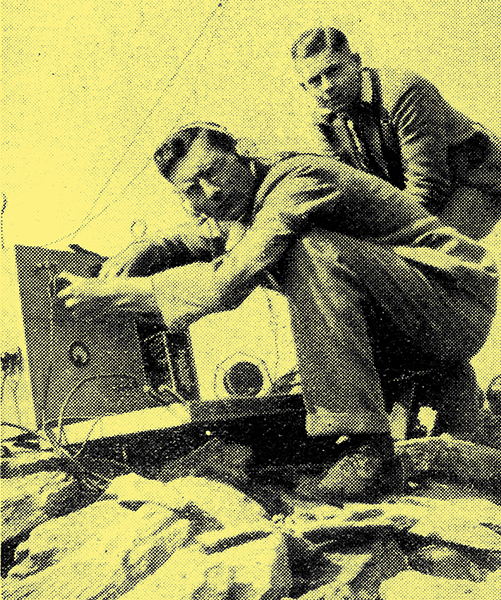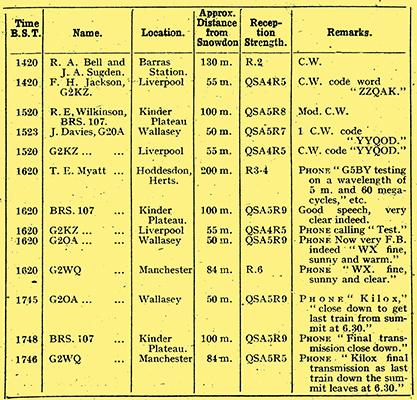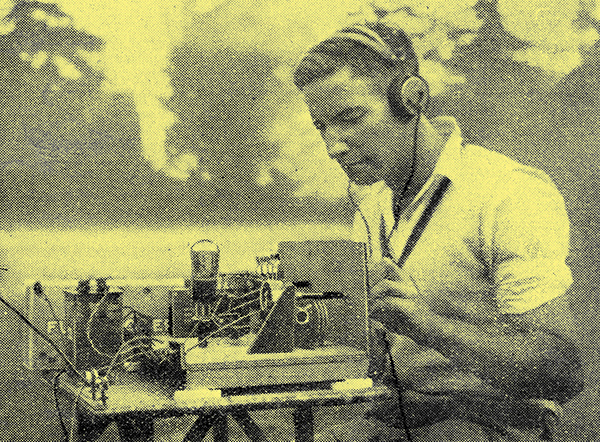|
Operating a Wireless World Ultra Short Wave Two receiver at Hoddesdon, Herts, on Saturday, August 12th, Mr T E Myatt picked up the 5-metre transmissions of Mr Hilton O'Heffernan (G5BY) from the summit of Mount Snowdon, approximately 200 miles away. The two experimenters have thus broken the world record for communication on 'optical' wavelengths.

Messrs. H L O'Heffernan and H L Harris operating G5BY on the summit of Snowdon.
From the large circular pile of rocks which marks the highest point on Snowdon (3,570 feet) G5BY, accompanied by G6UH, transmitted on 5 metres for about eight hours continuously on Saturday, August 12th. The summit was reached shortly after 8.30 am, and the work of erecting both stations began immediately.
The first transmissions began from both stations at 9.40 am and continued at irregular intervals until 12.20 pm, when the published schedules were commenced. Throughout the day the experimenters were unaware whether their signals were being heard, for although two receivers were used throughout each listening period, no answering signal was picked up. This was naturally disappointing but not entirely unexpected, as it was known that very few transmitters were working. In many cases this was due to the fact that many experimenters were unable to participate until the afternoon, it being a Saturday. The test, however, had to be carried out on a Saturday, there being no Sunday trains up the mountain.
It was not until late in the day, when a telegram was received from G2WQ in Manchester notifying reception at 84 miles, that it seemed possible that startling reports might be expected. Obviously, however, the majority of reports would come late and could not be received before Monday or Tuesday. Every post brought fresh evidence of success, culminating on Tuesday by the arrival of a report from Mr T E Myatt, of Hoddesdon, Herts, which checked perfectly with G5BY's log and those of other listeners, thus proving that reception of speech had been achieved over approximately 200 miles from the mountain summit.
G5BY's transmitter employed an eight-foot vertical aerial with the transmitter at the centre. The HT of 300 Volts was obtained from an Electro Dynamic motor generator driven from a 12 Volt car starter battery. G6UH, the companion transmitter, employed a similar layout.
It is impossible to reproduce here the complete log, but the extracts in the accompanying table show how the reports cross-check each other.

How I Logged Snowdon

Mr T E Myatt of Hoddesdon, Herts, with The Wireless World Ultra Short Wave Two on which he heard G5BY's signals at a distance of 200 miles.
My set, a slightly modified Wireless World Ultra Short Wave Two, was set up on porcelain insulators (to avoid stray HF) on a table in a near-by cricket field. The antenna consisted of a loft length of seven-strand wire suspended by, and insulated from, a piece of string attached to the top corner of a wooden batting screen. An earth connection was made by driving a long screwdriver into the soil and connecting this by a 4 ft length of wire to the set. The ground was extremely dry and had to be damped.
When trying out the set previously I had found that by coupling the aerial by an 0.00005 μF trimmer an infinitely higher degree of sensitivity could be obtained. A watch was kept from 12.15 (BST) to 17.30 (BST). Soon after switching on at 12.25, I picked up the carrier wave of G5BY on 60 MHz. at a strength of R1-2. I held it for about two or three minutes, when a loud burst of X's blotted it out. Thereafter no other signals were received until 16.21, when, in the last stages of disappointment and exasperation, I was lucky enough to tune in at R3-4. 'This is G5BY testing on a wavelength of 5 metres and 60 Mc' A sudden burst of 'sausage frying' indicated the proximity of a plane, which, after circling round the field and blotting out all signals with its ignition, suddenly switched off, and I was able to hear a reference to Mount Snowdon from G5BY. No further sounds from Snowdon were heard; I suppose the interruption was due to the change in the weather, for a bank of heavy clouds rolled up. The watch continued from 16.20 until 17.30.
A number of unidentified Morse stations were logged during the day, though the Brookmans Park transmitters provided an annoying background all over the dial. No doubt I was receiving the sixth harmonic. A curious, feature of the transmission tests was that no trace could be discovered of the other transmitter, G6UH on 56 MHz.
|